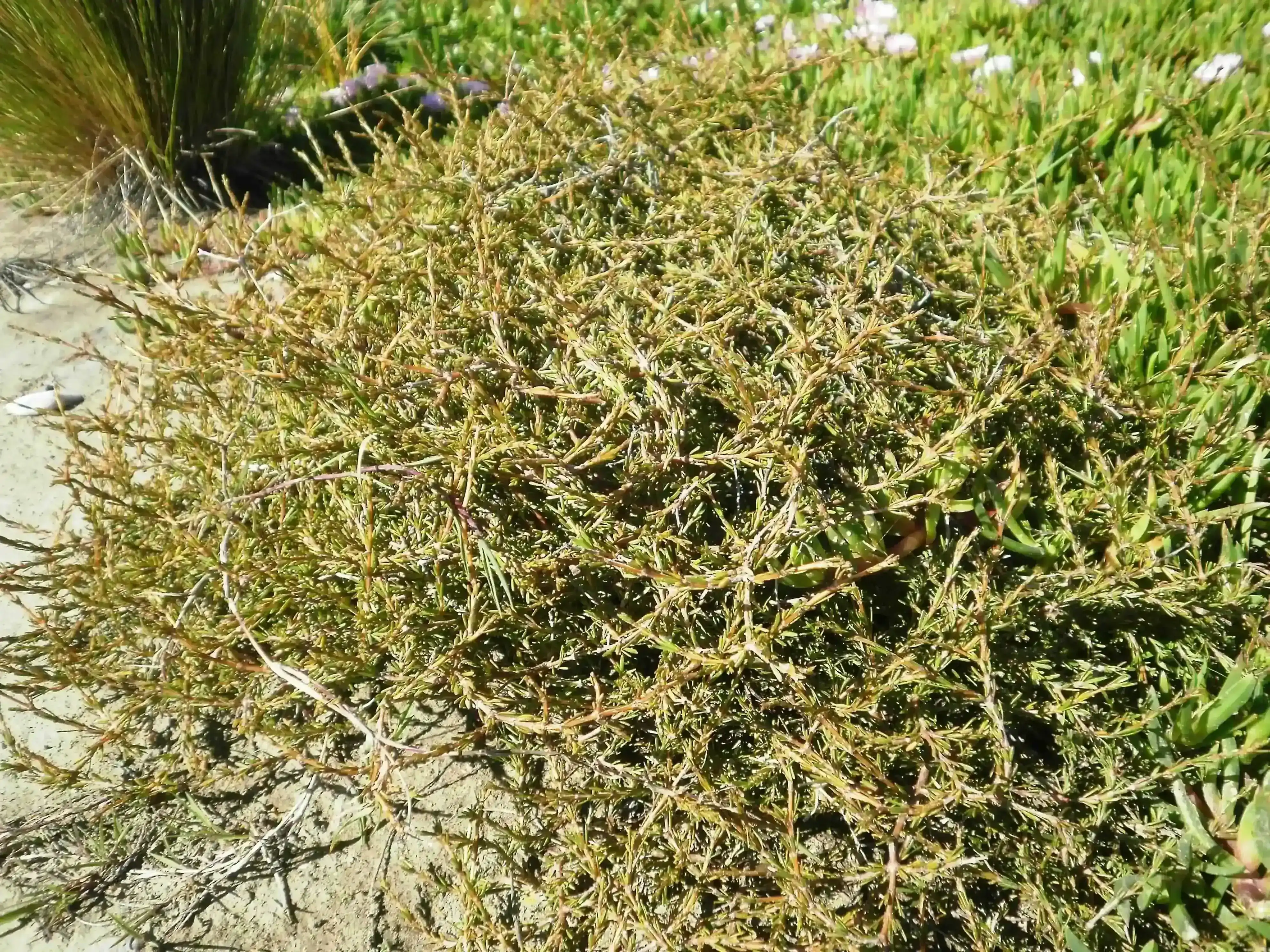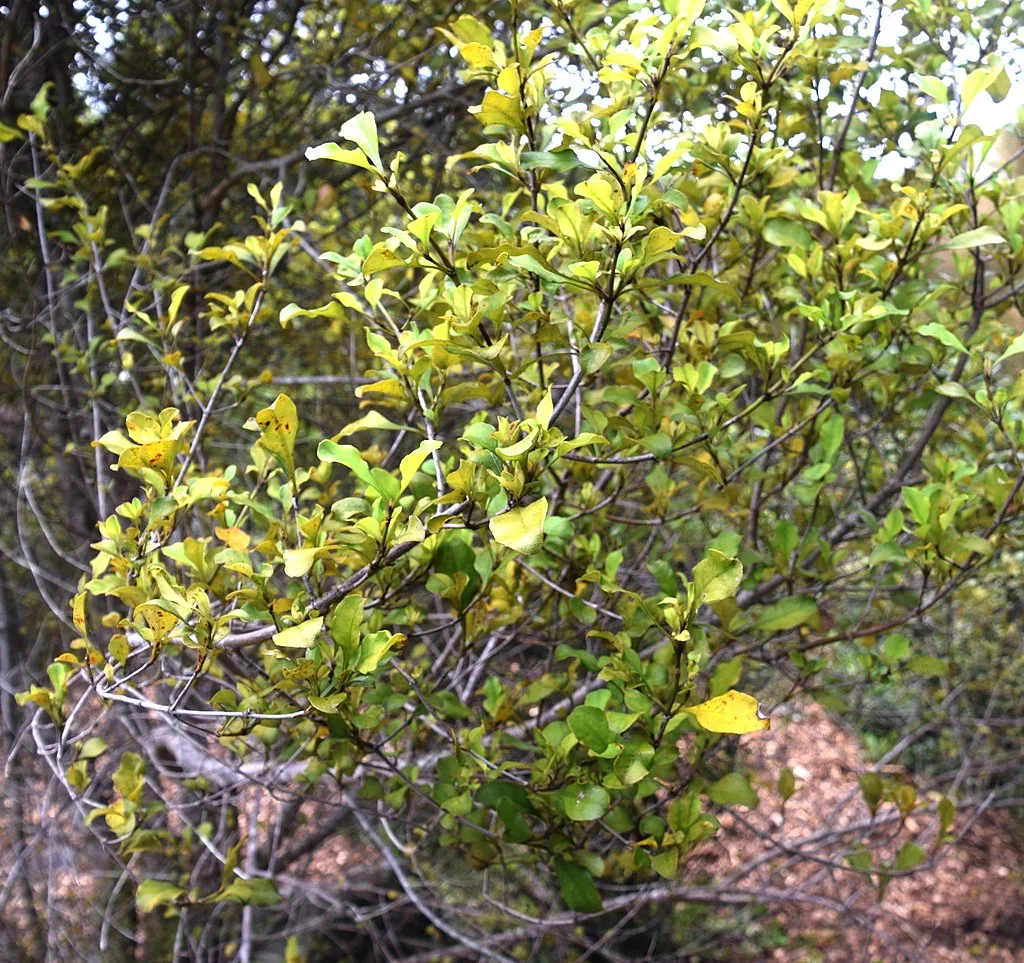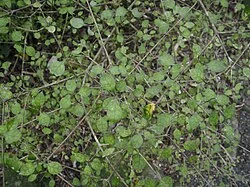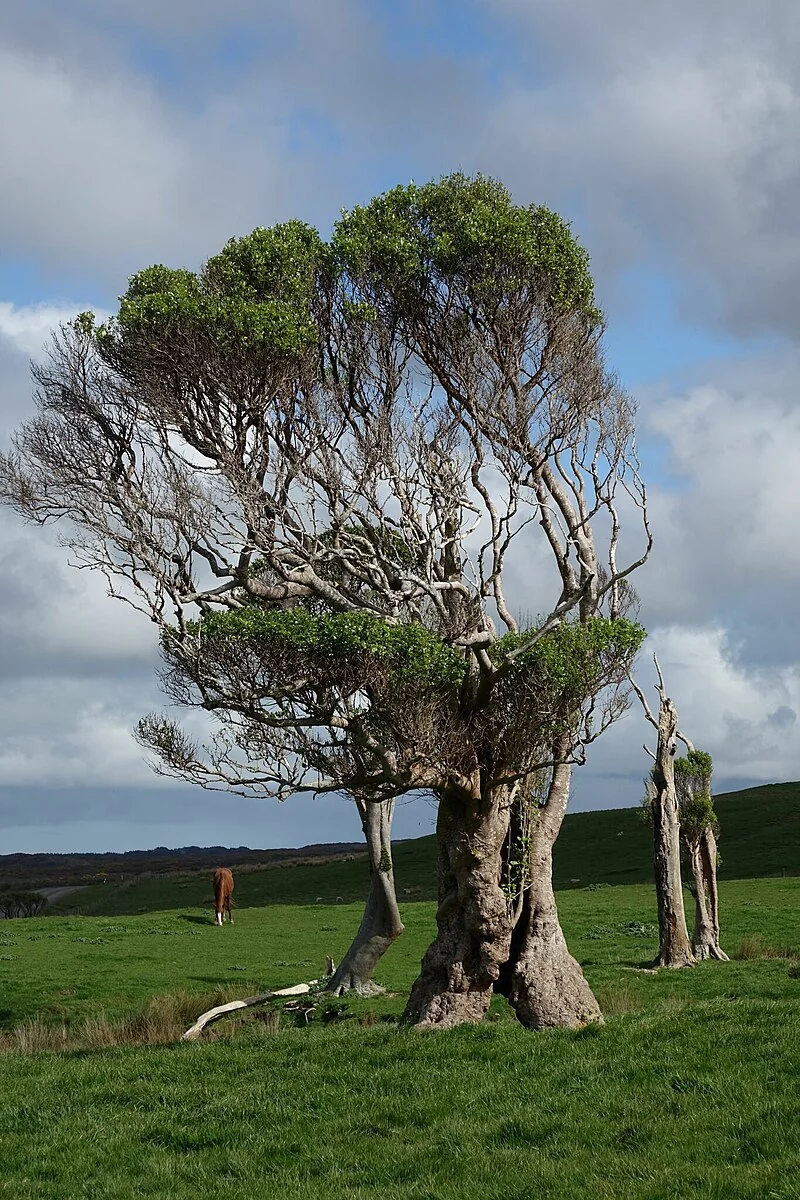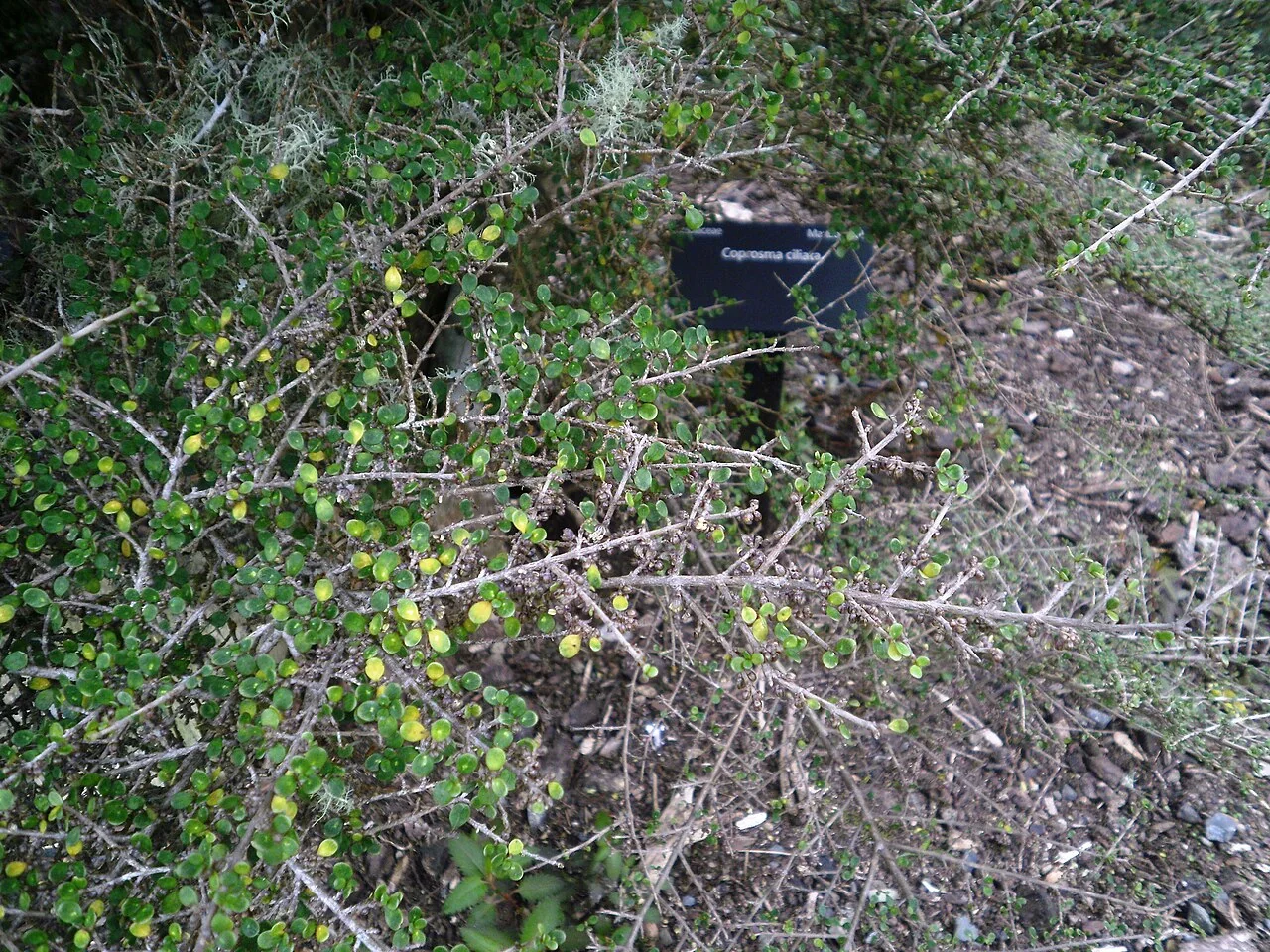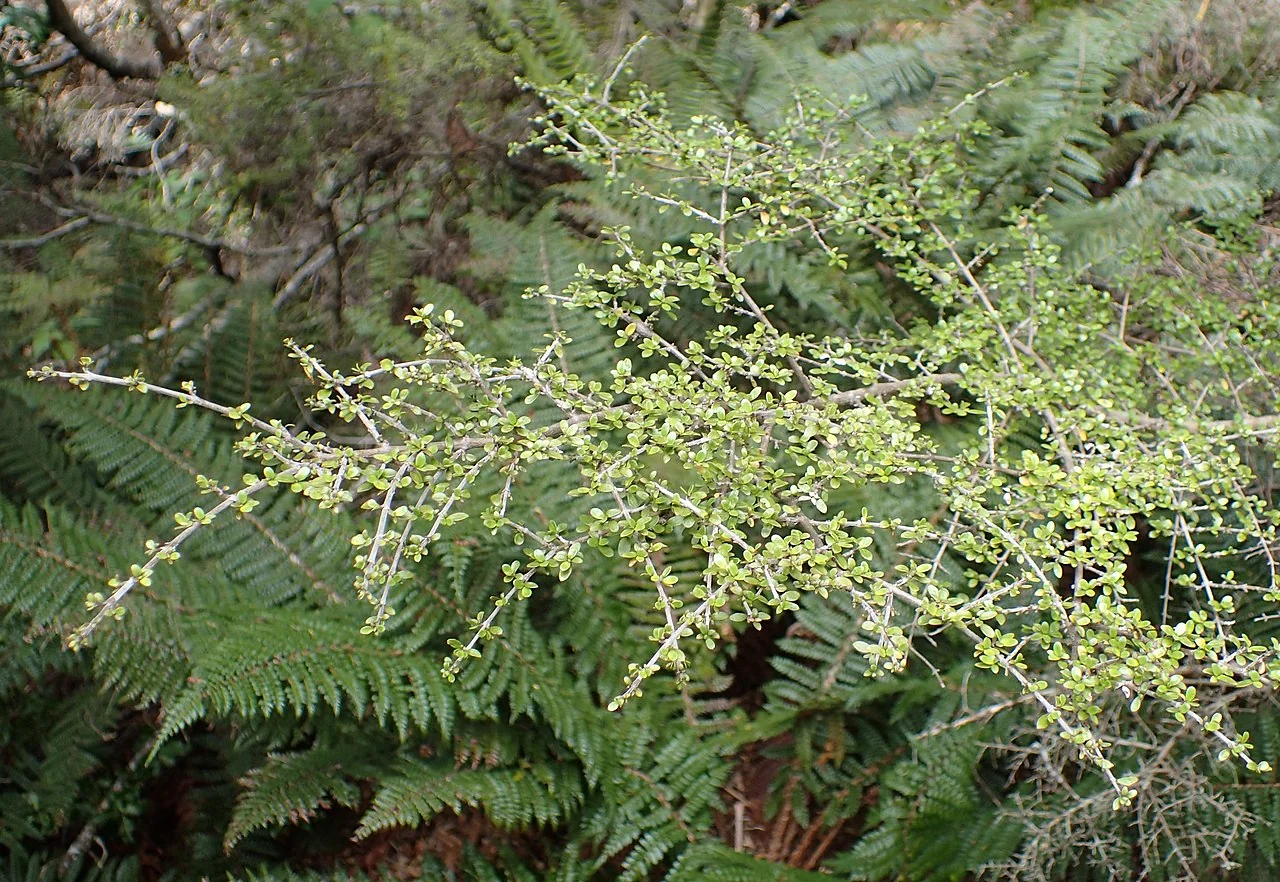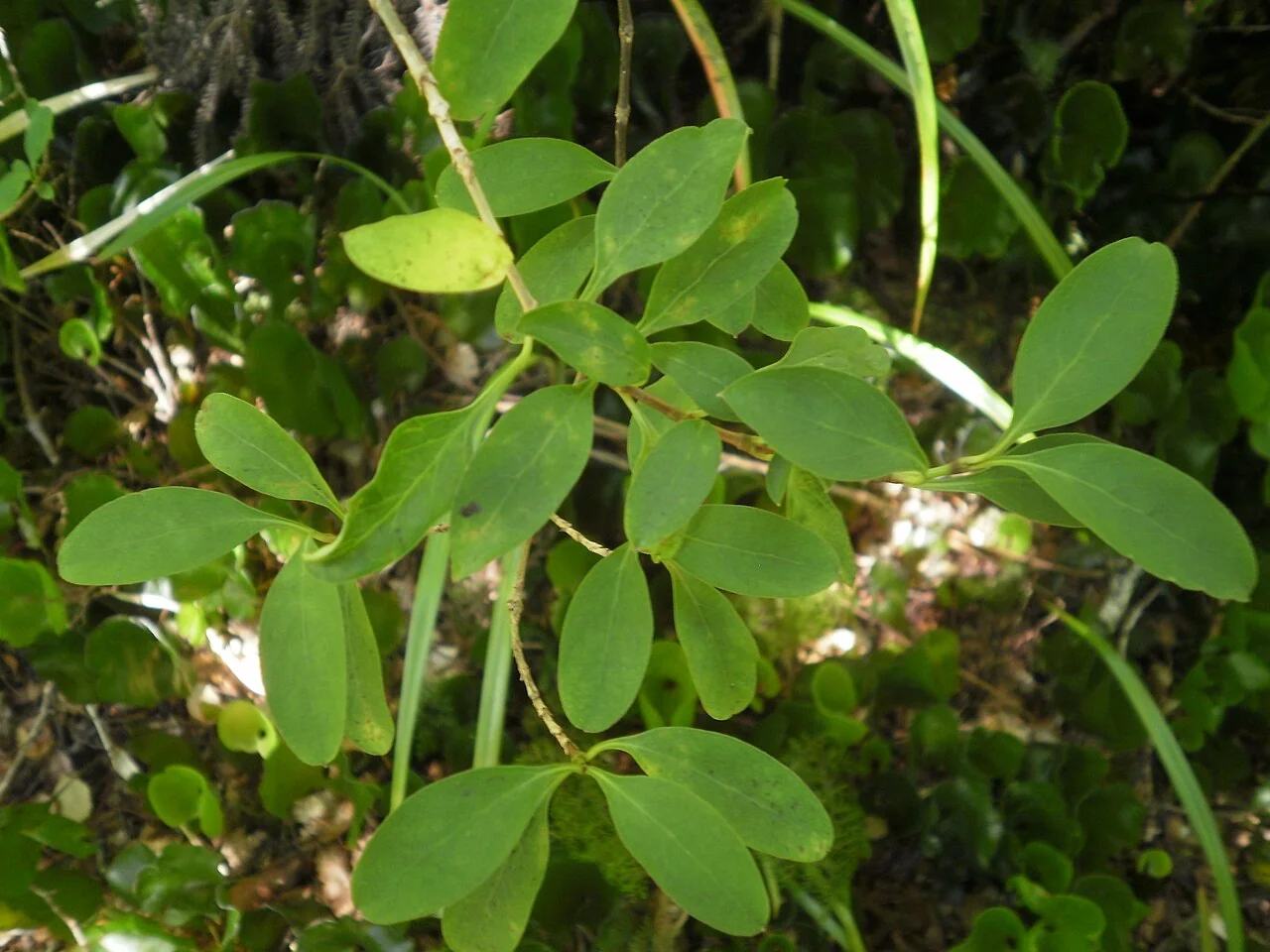
Stinkwood
Coprosma foetidissima
Coprosma foetidissima , commonly known as stinkwood or hūpiro (Māori), is a species among New Zealand's native shrubs in the family Rubiaceae, native to New Zealand, including the North, South, Stewart, and Auckland Islands. Its most distinctive characteristic is the unpleasant, rotten cabbage or dung-like smell produced when its leaves are crushed or bruised. This odor is caused by the sulfur compound methanethiol. It grows as an evergreen shrub or small tree, typically reaching up to 3 meters (9.8 feet) tall, though it can occasionally grow up to 6 meters (20 feet) in some areas like the Auckland Islands. It has an open-branched structure with rather brittle branches and dark brown bark. The leaves are thin, pale green, 1-2 cm long, and are widest in the middle, tapering towards the tip and base. The plant is dioecious, meaning male and female flowers are borne on separate plants. Flowering occurs between October and November, with solitary flowers appearing at the ends of branchlets. The fruit, known as a drupe, is pale to full orange, oblong, and 7-10 mm long, ripening between March and July. While the fruit is described as having little flavor and tasting "horrible," the roasted seeds can be used as a coffee substitute. Coprosma foetidissima is found in coastal to subalpine forest, shrubland, and occasionally grasslands.

Plant Description
Botanical Features
Coprosma foetidissima , commonly known as Stinkwood or hūpiro (Māori), is an evergreen shrub or small tree native to New Zealand, including the North, South, Stewart, and Auckland Islands. Its most distinctive characteristic is the strong, unpleasant odor it emits when its leaves are crushed or bruised, often described as resembling rotten cabbage or dung. It typically grows up to 3 meters tall, with an open-branched structure and brittle branches. The leaves are thin, pale green, 1-2 cm long, and widest in the middle. It produces solitary, inconspicuous flowers between October and November, followed by pale to full orange, oblong drupes (berries) that are 7-10 mm long, ripening between March and July. It is found in coastal to subalpine forest, shrubland, and occasionally grasslands.
Quick Facts
| Scientific Name | Coprosma Foetidissima |
|---|---|
| Height | 2-5 m |
| Spread | 2-4 m |
| Water Needs | Low to moderate |
| Light | Full sun to part shade |
| Frost Tolerance | Good |
| Salt Tolerance | Moderate |
| Growth Rate | Fast |
| Lifespan | Medium to long |
Climate Best Suited to
White maire (Nestegis lanceolata) is primarily found in lowland to hilly forests across the North Island of New Zealand, extending to the Marlborough Sounds in the South Island. It demonstrates good adaptability to various conditions, thriving in areas with well-drained soils and tolerating both full sun and partial shade. Its natural distribution suggests a preference for warmer, more humid environments but with a reasonable tolerance for cooler temperatures found in its southern range.
Regional Suitability
| Whangārei | Ideal |
| Auckland | Ideal |
| Hamilton | Suitable |
| Rotorua | Suitable |
| Tauranga | Ideal |
| Gisborne | Ideal |
| New Plymouth | Ideal |
| Whanganui | Ideal |
| Palmerston North | Suitable |
| Napier | Ideal |
| Wellington | Ideal |
| Nelson | Ideal |
| Christchurch | Suitable |
| Dunedin | Suitable |
| Invercargill | Suitable |
| City | Climate Suitability |
|---|
Habitat
Natural Distribution
Coprosma foetidissima , commonly known as Stinkwood, is native to New Zealand and thrives in a diverse range of habitats. It can be found from coastal areas to sub-alpine zones, including forests, shrublands, and occasionally grasslands. This adaptable species is distributed across mainland New Zealand, as well as on Stewart Island and the Auckland Islands, growing from sea level up to 1800 meters in elevation.
Plant Conservation
Coprosma foetidissima , also known as stinkwood or hūpiro, is currently classified as "Not Threatened" in the 2023 New Zealand Threat Classification Series for vascular plants. Additionally, it is listed as "Least Concern" on the 2025 IUCN Red List of Threatened Species.
This species is endemic to New Zealand, found from the Coromandel Peninsula southwards to Stewart Island and the Auckland Islands, growing in coastal to sub-alpine forest and shrubland. Despite its "Not Threatened" status, it is considered important for biodiversity as it is the type species for the Coprosma genus and supports a high level of endemic invertebrate diversity.
Growing Requirements
Soil Requirements
White maire (Nestegis lanceolata) is remarkably adaptable to different soil conditions, thriving in well-drained environments. It can tolerate a variety of soil types, from sandy to loamy, and prefers a neutral to slightly acidic pH. Good drainage is crucial to prevent root rot, ensuring healthy growth and development.
- Tolerates a wide range of soil types from clay to sandy
- Prefers well-draining soils but can handle occasional waterlogging
- Thrives in moderately fertile soils but will grow in poor soils too
- Can tolerate slightly acidic to slightly alkaline pH
- Handles coastal conditions including salt spray
Light Requirements
White maire (Nestegis lanceolata) thrives in a variety of light conditions, from full sun to partial shade. Optimal growth and flowering are typically achieved in locations receiving ample sunlight throughout the day. However, it can also tolerate some shade, especially in hotter climates, where it benefits from protection during the most intense afternoon sun.
- Full sun for optimal growth and form
- Can tolerate partial shade but may develop a leggier form
- At least 6 hours of direct sunlight daily is ideal
- Northern or eastern exposures work well in garden settings
Water Requirements
Once established, White maire (Nestegis lanceolata) is remarkably drought-tolerant, requiring minimal supplemental watering. During its establishment phase, consistent moisture is crucial to encourage strong root development. Mature plants can withstand dry periods, but regular watering during prolonged droughts will promote healthier growth and more abundant flowering.
- Moderate watering during establishment (first 1-2 years)
- Drought-tolerant once established
- Can handle periods of soil saturation
- Reduce watering in winter when growth slows
- Signs of overwatering include yellowing leaves and crown rot
Planting Guide
How to Plant
When planting Coprosma foetidissima , choose a site with appropriate light and soil conditions. It is highly adaptable and can tolerate a wide range of light, from full sun to partial shade. For soil, it prefers well-drained conditions and can grow in various types, including sandy and loamy soils. A neutral to slightly acidic pH is ideal. If your soil is heavy or clay-based, consider incorporating gypsum to improve drainage. This species is exceptionally hardy and can handle exposed, windy, coastal, and even alpine conditions.
In the Ground
- Dig a hole that is twice as wide and to the same depth as the plant's root ball.
- Enrich the soil with organic matter like compost or organic plant food.
- Carefully remove the plant from its container, gently tease out the roots, and trim any tangled or circling roots.
- Position the plant in the hole so that the top of the root ball is level with the surrounding ground.
- Backfill with soil, gently firming it down around the roots.
- Create a raised, doughnut-shaped ring of soil around the outer edge of the plant's root zone to help retain water.
In a Pot
- Choose a pot at least 200 mm wide and deep.
- Fill the pot with a quality potting mix.
- Follow the same steps for removing the plant from its container and positioning it, then backfill with potting mix.
After Planting Care
Water thoroughly immediately after planting to settle the soil. Keep the soil moist for several weeks while the plant establishes, watering deeply once or twice a week depending on weather conditions. Once established, Coprosma foetidissima is relatively drought-tolerant and requires very little watering.
Feeding
During the growing season (spring to autumn), feed with an all-purpose granular or liquid plant food.
Ecological Significance
Coprosma foetidissima plays a significant role in New Zealand's ecosystems. It is a food source for a variety of endemic insects, including gall mites, caterpillars of moths and butterflies, scale insects, sucking bugs, and gall fly larvae. Larvae of weevils also inhabit its dead wood, and the Wellington tree wētā has been observed feeding on its leaves. The leaves of C. foetidissima often feature domatia, small indentations on the underside that may house beneficial insects like mites.
The plant's fleshy orange drupes, produced between March and July, are dispersed primarily by birds, contributing to seed dispersal and the regeneration of native forests and shrublands. Its adaptability to diverse habitats, from coastal to subalpine zones, highlights its importance in maintaining biodiversity across various New Zealand landscapes.
Uses and Significance
Garden Uses
- Specimen tree for visual impact
- Suitable for native gardens and restoration projects
- Enhances native garden aesthetics and biodiversity
- Provides architectural accent with its unique structure
- Effective for erosion control on slopes and banks
Ecological Value
Ecologically, White maire (Nestegis lanceolata) plays a crucial role in supporting native ecosystems. Its fruits are a food source for birds, especially the kererū, contributing to the local biodiversity and food web.
- Provides a vital food source for native birds, especially the kererū
- Offers habitat and nesting sites for various fauna
- Contributes to soil stabilization and nutrient cycling
- Forms natural shelter belts, protecting other species
Cultural Significance
Traditional Uses and Values
Stinkwood, or hūpiro, holds cultural significance for Māori due to its distinctive odor and various traditional uses. While its strong smell (hūpiro) might be off-putting, it was recognized for its medicinal properties in rongoā (traditional Māori medicine). The plant's berries were also a food source, and its wood was used for various purposes. Its unique characteristics and presence across diverse habitats contributed to traditional ecological knowledge.
Landscaping Uses
Garden Design Applications
Coprosma foetidissima is a versatile native shrub that can be effectively incorporated into various landscaping designs in New Zealand. Its bushy habit and tolerance to different conditions make it suitable for a range of applications.
- Bird and Bee Attractant: The plant's berries and flowers provide a valuable food source, attracting native birds and bees to your garden.
- Forest and Riparian Plantings: Ideal for ecological restoration projects, especially in forest and riverside areas, where it helps stabilize soil and contributes to natural habitat.
- Hedging: Can be used for informal hedging, providing a natural and dense screen.
- Specimen Plant: Its unique form and seasonal berries can make it an attractive specimen plant in a native garden.
- Coastal Gardens: Its wind and salt tolerance make it a good choice for coastal areas.
Seasonal Care Calendar
Spring
In spring, White maire (Nestegis lanceolata) begins its active growth phase. New foliage emerges, and it's an ideal time for planting new specimens or propagating. Ensure adequate moisture and monitor for early signs of pests.
- New growth begins with fresh foliage development
- Apply a balanced, slow-release fertilizer if desired
- Excellent time for planting new specimens or dividing offsets
- Monitor for new pest activity and address promptly
Summer
Summer is the peak growing season for White maire (Nestegis lanceolata), often accompanied by flowering. Consistent watering is important, especially for young plants, to support vigorous growth and prevent stress during dry periods.
- Flowering typically occurs in early to mid-summer (November-January)
- Water young trees regularly during extended dry periods
- Avoid heavy pruning during the active growing season
Autumn
During autumn, White maire (Nestegis lanceolata) prepares for the cooler months. Fruits or berries develop, providing food for native birds. It's also a good time for planting and general garden cleanup.
- Fruits or berries develop and ripen (December-February), attracting birds
- Natural leaf shedding occurs as part of its growth cycle
- Good time for planting new specimens to establish before winter
- Clean up fallen leaves if a tidy appearance is desired
Winter
Winter is generally a dormant period for White maire (Nestegis lanceolata). Minimal care is required, though young plants may benefit from protection in colder regions. This is an opportune time for any necessary structural pruning.
- Generally dormant with minimal growth activity
- No special winter protection needed in most mild climates
- Suitable time for structural pruning if required
- Fallen leaves can be left as mulch or removed for tidiness
When to Prune and How Much
White maire (Nestegis lanceolata) generally requires minimal pruning to maintain its natural form and health. Pruning should focus on removing dead or damaged growth and shaping the plant as needed.
- Remove dead, damaged, or diseased branches at any time of year
- Light formative pruning when young helps establish good structure
- To create a multi-trunked specimen, cut the main stem to encourage branching
- Fallen leaves can be removed for a tidier appearance, or left as natural mulch
- If necessary, lower branches can be removed to create clearance underneath
- Major pruning is best done in late winter to early spring before new growth
Always use clean, sharp tools for pruning to minimize the risk of disease and ensure clean cuts. The plant often responds well to pruning with vigorous new growth, contributing to a fuller, healthier appearance.
How to Grow Stinkwood
From Fresh Orange Berries
Fresh orange berry propagation represents the most reliable and natural method for growing Stinkwood, taking advantage of this fast-growing species' abundant fruit production and natural dispersal strategy that has enabled it to establish across diverse New Zealand environments from coastal to subalpine elevations. This hardy endemic produces prolific pale to full orange oblong drupes during March to July that provide exceptional opportunities for propagation while supporting the species' natural frugivory dispersal cycles essential for ecosystem function. The species' adaptation to both forest and disturbed environments makes it particularly valuable for restoration projects and wildlife gardens requiring resilient plants capable of handling variable growing conditions while providing important food resources for native birds. Fresh berries yield significantly higher germination success compared to stored seeds, making immediate processing and sowing the preferred approach for both conservation propagation and garden cultivation of this ecologically important shrub. Collect ripe berries during March to July when fruits have achieved their characteristic orange coloration and can be easily removed from brittle branches, timing collection to coincide with peak ripeness when seeds have reached maximum viability for successful establishment. Choose berries that are fully developed, firm, and show the distinctive orange coloration typical of mature fruit, avoiding any that appear damaged, diseased, or prematurely dropped which might indicate compromised seed quality. Process berries immediately after collection by macerating in water and thoroughly cleaning seeds, using gentle rubbing under running water to separate seeds from the mucilaginous pulp that could inhibit germination or promote fungal growth during establishment. Clean seeds by repeated washing until all fruit debris is removed, retaining the small seeds that settle to the bottom while discarding floating material that typically indicates poor viability or damaged genetic material. Prepare optimal germination medium using very free-draining seed-raising mix with excellent aeration properties, ensuring pH levels between 6.0-7.0 that support healthy development for this adaptable forest edge species. Sow fresh seeds immediately after processing, covering lightly with 2-3mm of fine sand to provide optimal conditions for germination while maintaining protection from drying out that can quickly kill developing embryos. Provide optimal environmental conditions including consistent temperatures between 15-22°C and bright light that supports germination while maintaining even moisture without waterlogging throughout the extended germination period. Maintain careful moisture management throughout the 4-10 week germination period, as germination can be slow and staggered, requiring patience and consistent environmental conditions while monitoring for emergence signs. Keep propagation trays for extended periods to accommodate the variable germination timing characteristic of this species, ensuring optimal conditions are maintained throughout the potentially lengthy emergence window. Young seedlings develop at moderate rates while establishing the root systems necessary for adaptation to diverse growing conditions, requiring prompt transplanting into tubes of sandy, gritty mix when large enough to handle. Grow seedlings in high light conditions with modest feeding regimens that support healthy development without promoting excessive soft growth vulnerable to environmental stress during establishment. Harden off gradually before planting into sunny to lightly sheltered, free-draining sites that replicate the natural forest edge conditions where this species thrives while providing wildlife food resources.
From Semi-Hardwood Cuttings
Semi-hardwood cutting propagation offers a reliable vegetative method for growing Stinkwood that preserves the exact genetic characteristics of superior parent plants while providing consistent results for experienced propagators working with native plant cultivation and restoration projects. This approach is particularly valuable for maintaining exceptional specimens that demonstrate superior growth habits, enhanced fruit production, or other desirable traits that can be preserved through careful vegetative propagation techniques suited to this fast-growing endemic species. The method works well with Stinkwood because of this species' natural ability to develop adventitious roots under appropriate growing conditions, making it suitable for both commercial nursery production and specialized propagation programs. Take 6-8cm semi-hardwood cuttings from healthy current-season shoots during late spring through early autumn when growth has achieved optimal maturity for rooting while retaining sufficient vigor for successful establishment under controlled propagation environments. Select healthy, vigorous shoots from the middle portions of branches that display the characteristic thin pale green leaves and robust growth typical of healthy Stinkwood development, avoiding both very soft growth and completely hardened wood that may resist rooting. Cut sections with clean, sharp secateurs, ensuring each cutting includes appropriate nodal development while selecting material that represents the best characteristics of the parent plant including vigorous growth habit and healthy foliage development. Remove lower leaves carefully to reduce transpiration stress while retaining sufficient photosynthetic capacity in upper leaves, taking care not to damage the thin leaves that provide energy for root development during the establishment period. Lightly wound the base if stems are smooth to enhance root initiation, using gentle scraping techniques that expose cambium tissue without causing excessive damage to cutting material. Apply rooting hormone of low to moderate strength immediately after preparation, using formulations appropriate for semi-hardwood native species to enhance root initiation while ensuring even coverage of cut surfaces where new root systems will develop. Insert prepared cuttings into coarse, very free-draining medium such as 1:1 perlite and coarse sand, ensuring excellent drainage while maintaining the consistent moisture levels essential for successful root development without creating waterlogged conditions. Maintain optimal environmental conditions including bright light, high humidity without leaf wetness, and gentle bottom heat around 18-22°C if available, providing conditions that support root development while preventing cutting stress. Provide bright light that supports photosynthesis without causing excessive transpiration stress, replicating the filtered light conditions where this species naturally thrives in forest edge environments. Keep growing medium just moist throughout the 4-8 week rooting period, maintaining consistent environmental conditions while watching for signs of successful root development including new shoot growth and resistance when gently tested. Root development occurs gradually as cuttings establish the fibrous root systems characteristic of mature Stinkwood plants, requiring patience and consistent care throughout the establishment process. Pot successful cuttings into sandy, well-drained mix and harden off gradually before planting into permanent locations, providing growing environments that support transition from propagation to garden cultivation where they can contribute to native plant communities.
From Natural Layering
Natural layering provides an excellent propagation method for Stinkwood that takes advantage of this species' natural growth habit and brittle branching structure that often creates opportunities for vegetative reproduction in wild populations. This technique works particularly well with Stinkwood because of its open-branched structure with rather brittle branches that naturally bend and contact the ground, creating conditions favorable for adventitious root development under forest conditions. The method mimics natural reproduction strategies while providing reliable results for gardeners seeking to propagate specific genetic lines or difficult selections that may not respond well to other propagation techniques. Understanding this natural process provides insights into the species' ecology while offering practical propagation techniques that require minimal specialized equipment or advanced skills. Select healthy, flexible low branches from vigorous parent plants during the growing season when active growth supports rapid root development, choosing branches that can be easily brought into contact with prepared growing medium. Identify suitable layering locations where selected branches can be positioned in contact with soil or growing medium while remaining connected to the parent plant's established root system throughout the critical establishment period. Prepare layering sites by incorporating organic matter and ensuring adequate drainage characteristics that support root development while avoiding waterlogged conditions that can inhibit successful establishment. Create partial wounds in branch sections that will be buried by making small cuts or scraping away bark to expose cambium tissue where new roots will develop most readily without severely damaging the layering material. Pin wounded branch sections in contact with prepared growing medium using wire pins, small stones, or other securing methods that maintain consistent contact while allowing natural growth processes to proceed. Cover layered sections with shallow soil or a small pot of gritty growing mix, providing growing conditions that support root development while maintaining the moisture levels necessary for successful establishment without creating waterlogged conditions. Mark layering sites clearly to prevent accidental disturbance and maintain consistent moisture throughout the rooting period, as reliable water availability is critical for root development in this species that requires careful moisture management. Monitor layered sections regularly for signs of successful rooting, typically indicated by new shoot growth emerging from buried areas after several months under favorable growing conditions. This method can be slower than cuttings but proves useful for difficult selections or when maintaining connection to parent plants throughout establishment provides advantages for challenging propagation situations. Sever connections to parent plants only after successful root establishment is confirmed, ensuring new plants have developed sufficient root systems to support independent growth before transplanting to permanent locations. This approach provides excellent success rates with relatively simple techniques while maintaining the genetic characteristics of superior parent plants, making it ideal for gardeners seeking to expand populations of this valuable native species through natural propagation methods.
Pests and Diseases
While Coprosma foetidissima is generally considered a hardy native shrub, it can be susceptible to certain pests and diseases.
Common Pests
- Scale insects and aphids: These are common sap-sucking insects that can occasionally affect Coprosma plants.
- Thrips: These tiny insects can damage leaves, flowers, and fruits by sucking juices, potentially leading to leaf dieback.
- Coprosma white erineum mite ( Phyllocoptes coprosmae ): This endemic gall mite causes white, hairy growths (erineum) on the underside of leaves and can result in yellow (chlorotic) spots on the upper leaf surface.
Potential Diseases
- Fungal diseases: Powdery mildew can occur, especially in humid conditions.
- Leaf spots: Common on New Zealand Coprosma species, often attributed to Mycosphaerella coacervata (or its anamorph, Phyllosticta coprosmae ), which causes purple blotches and necrotic patches on leaves.
- Rust: Can manifest as pale yellow, circular, or irregular spots on the underside of leaves, which then turn yellow on the upper surface and eventually brown. This affects Karamū and other Coprosma species.
- Phytoplasma (" Candidatus Phytoplasma australiense "): Associated with "Coprosma lethal decline" in related species like Coprosma robusta . Symptoms include interveinal chlorosis, abnormal leaf yellowing or reddening, slowed growth, and shoot dieback. This phytoplasma could potentially affect Coprosma foetidissima as well.
Bonus Tip
Expert Growing Advice
Despite its common name "Stinkwood" ( Coprosma foetidissima ) due to the unpleasant odor of its crushed leaves, this native shrub produces attractive orange berries that are a valuable food source for native birds. Planting it in your garden can contribute to supporting local wildlife, and its hardiness makes it suitable for a wide range of conditions, from coastal to subalpine environments.
